How Can I Fix My Audio Output Device Ffxiv
If you lot're having sound or audio problems, the following suggestions might help. The tips are listed in order, so outset with the get-go one, come across if that helps, and then go on to the next one if it doesn't.
Before you begin
Start by running the automated audio troubleshooter in the Get Help app. Become Assist automatically runs diagnostics and takes the correct steps to prepare well-nigh audio issues.
Open Become Help
If the Get Aid app is unable to resolve your sound or audio outcome, try the possible solutions listed:
If multiple audio output devices are available, check that you accept the appropriate one selected. Here'due south how:
-
Select the Speakers icon on the taskbar.
Annotation:If you don't see Speakers displayed, it may be in the overflow area. Select Bear witness subconscious icons to cheque there.
-
Side by side, select the arrow to open a list of audio devices connected to your reckoner.
-
Check that your sound is playing to the sound device you prefer, such every bit a speaker or headphones.
If this doesn't help, go along to the adjacent tip.
The audio troubleshooter might be able to set audio bug automatically.
To run the troubleshooter:
-
Go to Search in the taskbar, type sound troubleshooter, and select Observe and prepare problems with playing sound from the results to launch the troubleshooter.
-
Select Adjacent, and and so select the device you want to troubleshoot and so continue through the troubleshooter.
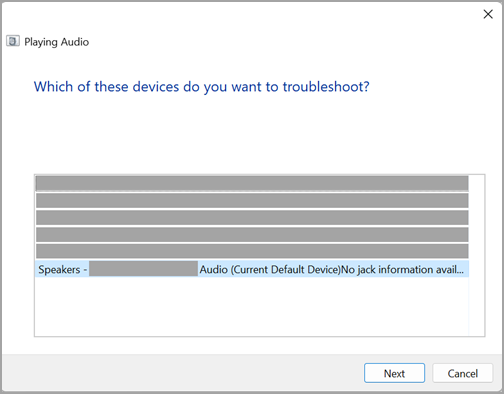
You can besides launch the troubleshooter from sound Settings:
-
Select First > Settings > Organisation > Sound > Troubleshoot common sound issues and select Output devices or Input devices.
If running the troubleshooter doesn't help, continue to the next tip.
To check for updates:
-
Do one of the following:
-
If the status says, "Yous're up to date," get to the side by side tip.
-
If the status says, "Updates are available," select Install now.
-
-
Select the updates you want to install, then select Install.
-
Restart your PC and cheque if your sound is working properly.
If that didn't solve your problem, continue to the next tip.
Try these steps:
-
Check your speaker and headphone connections for loose cords or cables. Make sure all cords and cables are plugged in.
-
If y'all have multiple 5mm jacks to plug into, especially on a surround audio system, make sure all cords and cables are plugged into the correct jack.
-
If it's not clear which jack goes with which cord, consult your hardware manufacturer, or try the most obvious outputs one at a fourth dimension and encounter if they work.
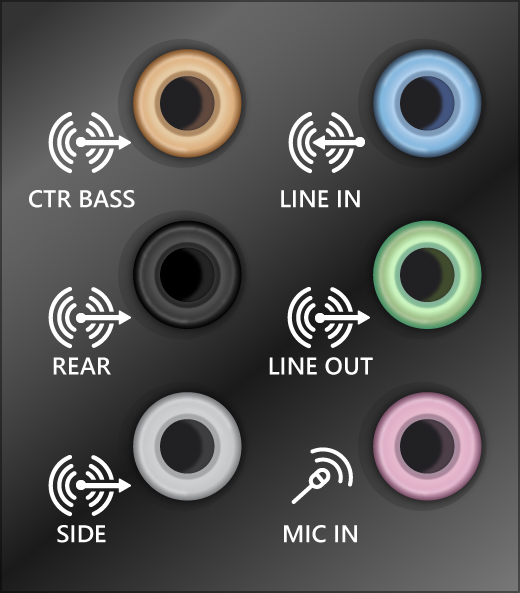
Note:Some systems use a green jack for output and a pink jack for mic input and others will exist labeled "headphone" or "microphone."
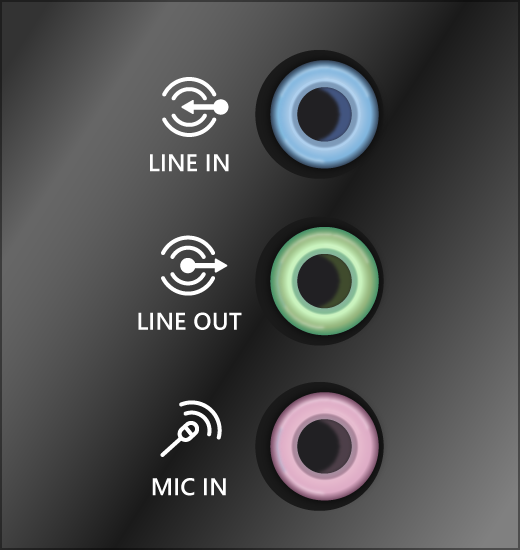
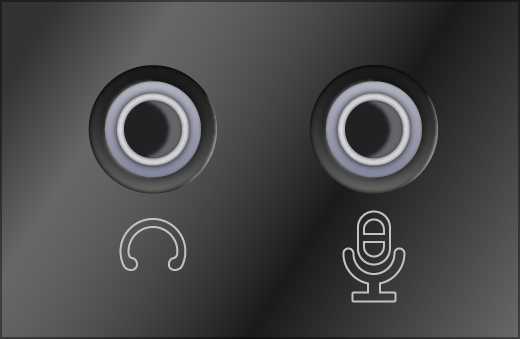
-
-
Make certain the power is turned on.
-
Make certain the mute setting is not turned on and try turning upward all the volume controls.
Annotation:Some speakers and apps have their own volume controls. Be certain to check them all.
-
Try connecting your speaker and headphones to a different USB port.
-
It's possible that your speakers won't work when your headphones are plugged in. Unplug your headphones and see if that helps.
If you're still having audio problems, see the side by side sections for boosted troubleshooting.
Check to make certain your audio devices aren't muted and haven't been disabled.
-
Select and hold (or right-click) the Speakers icon on the taskbar, and so select Open Volume mixer.
Notation:If yous don't see Speakers displayed, information technology may exist in the overflow area. Select Show hidden icons to check there.
-
You'll see a set of volume controls for your devices. Make sure none of them are muted. If whatsoever of them are muted, you'll run into an "x" next to the volume control . To unmute do one of the following:
-
Select the volume control and adjust to the desired book level.
-
Select the Unmute speakers icon.
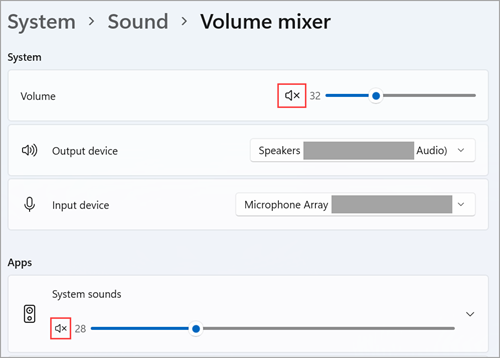
-
-
Check your device properties to make certain that your devices take not been disabled by mistake. Select Start > Settings > System > Sound .
-
Under Advanced, select More audio settings and select either the Playback (output) or Recording (input) tab.
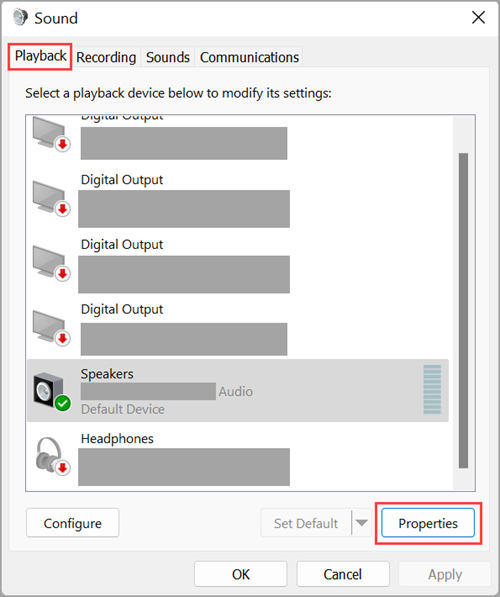
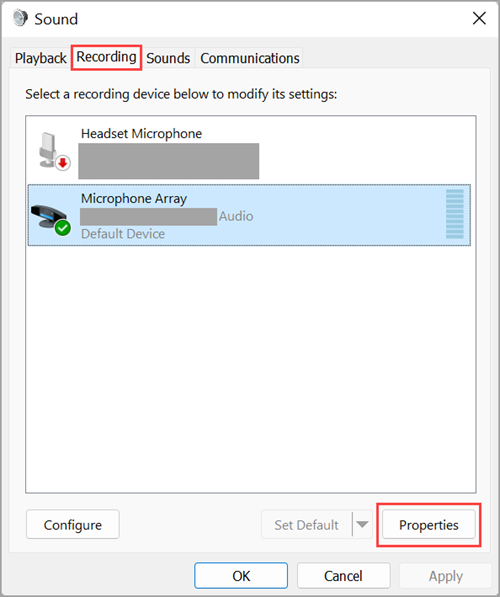
-
Select your device and and so select Properties.
-
Next to Device usage, check that Use this device (enable) is selected from the list for the output and input devices.
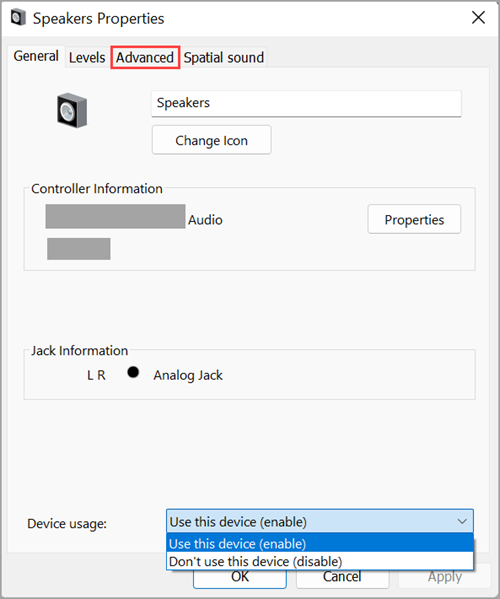
If that didn't solve your problem, keep to the adjacent tip.
Hardware problems can be acquired by outdated or malfunctioning drivers. Make sure your audio commuter is upwardly to engagement and update it if needed. If that doesn't work, try uninstalling the audio commuter (it will reinstall automatically). If that doesn't work, try using the generic audio driver that comes with Windows. If you're having audio problems after installing updates, effort rolling back your audio commuter.
To update your audio commuter automatically:
-
In the search box on the taskbar, type device manager, then select it from the results.
-
Select the arrow adjacent to Sound, video and game controllers to expand it.
-
Select and hold (or right-click) the listing for your sound card or audio device, such as headphones or speakers, select Update driver, then select Search automatically for drivers. Follow the instructions to complete the update.
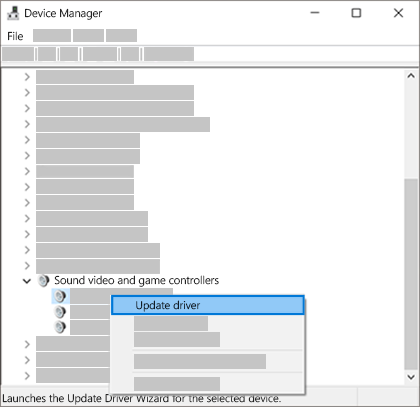
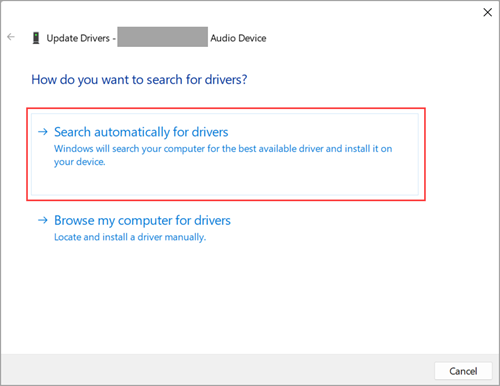
If Windows doesn't discover a new driver, look for one on the device manufacturer's website and follow those instructions. If that doesn't work, try uninstalling your audio driver.
To uninstall your audio driver:
-
In the search box on the taskbar, type device managing director, so select it from the results.
-
Select the arrow adjacent to Sound, video and game controllers to expand it.
-
Select and concur (or right-click) the list for your sound carte or audio device, select Uninstall device, select the Try to remove the commuter for this device check box, and then select Uninstall.
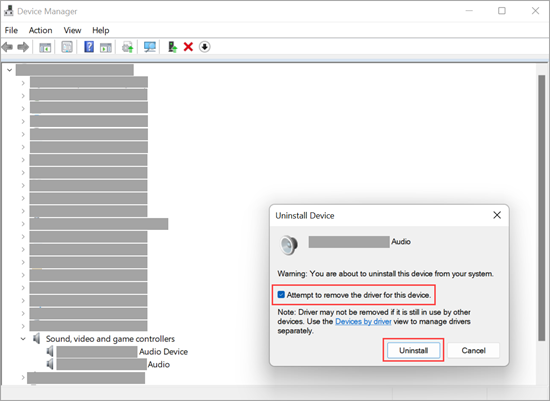
-
Restart your PC.
Note:Exist sure to salvage your documents and whatever other current work before you lot restart.
-
This restart volition automatically prompt your PC to reinstall your audio driver.
-
To restart, select Start > Power > Restart .
-
If those options didn't work, attempt using the generic sound driver that comes with Windows.
To use the generic audio driver that comes with Windows:
-
In the search box on the taskbar, type device manager, and so select it from the results.
-
Select the arrow next to Sound, video and game controllers to aggrandize it.
-
Select and concur (or right-click) the listing for your sound carte or sound device, and so select Update driver > Scan my computer for drivers> Let me pick from a list of available drivers on my computer.
-
Select the sound device whose driver y'all want to update, select Next, so follow the instructions to install it.
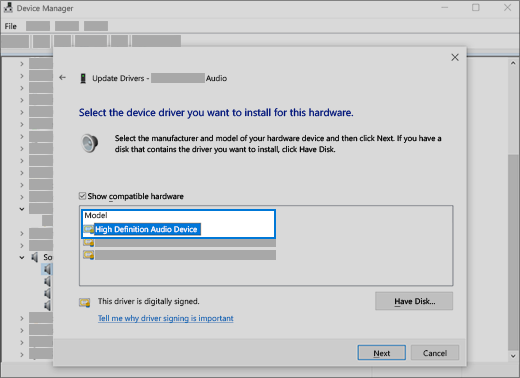
If these steps didn't solve your audio result, visit your device manufacturer'southward website and install the most recent audio/sound drivers for your device. The following is an case of a driver download page for a audio device manufacturer.
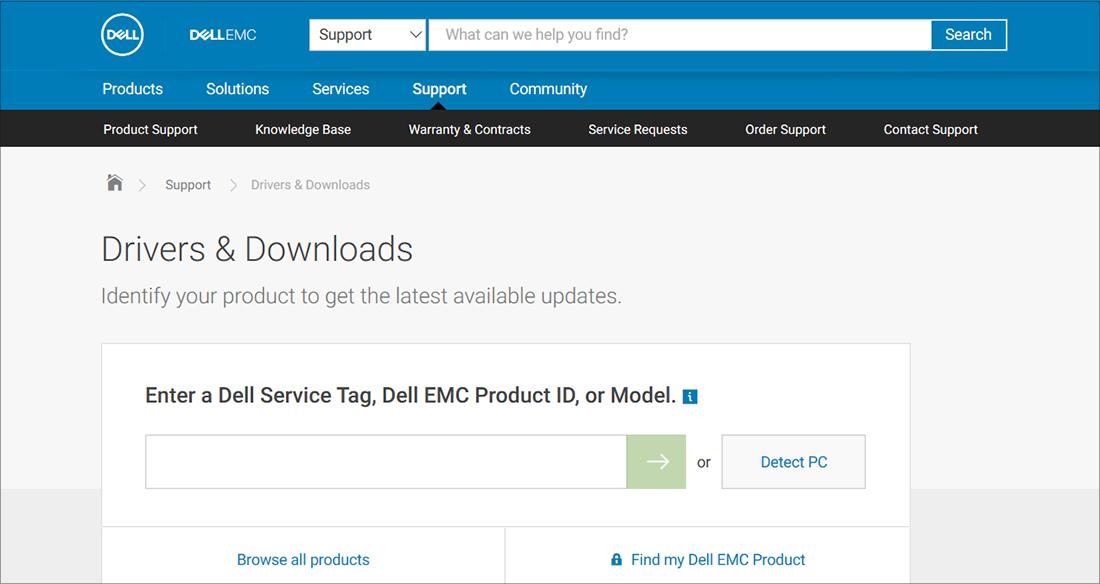
If you have audio issues afterward installing updates
If your sound was working before y'all ran Windows Update and now isn't working, try rolling back your sound driver.
To coil back your audio driver:
-
In the search box on the taskbar, type device manager, and then select it from the results.
-
Select the pointer side by side to Sound, video and game controllers to expand it.
-
Select and hold (or correct-click) the listing for your sound card or audio device, then select Backdrop.
-
Select the Driver tab, then select Roll Back Driver.
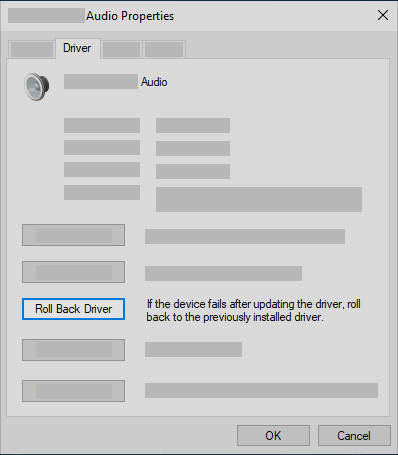
-
Read and follow the instructions and then selectYes if you lot desire to roll dorsum your audio driver.
If rolling back your sound driver didn't piece of work or wasn't an option, yous can endeavour to restore your PC from a organisation restore bespeak.
Restore your PC from a system restore point:
When Microsoft installs updates on your organisation, we create a system restore bespeak in example bug arise. Attempt restoring from that point and see if that fixes your sound problems. For more info, see "Restore from a arrangement restore indicate" in Recovery options in Windows.
If you're connecting to an audio device—such as headphones or speakers—using USB or HDMI, you might need to gear up that device every bit the default sound device. If yous're using an external monitor that doesn't take built-in speakers, brand sure that the monitor isn't already selected as your default output device. if it is, you lot won't take whatsoever audio. You can check that when you gear up your default output sound device. Hither'southward how:
-
In the search box on the taskbar, type control panel, then select it from the results.
-
Select Hardware and Sound from the Command Panel, and and then select Sound.
-
On the Playback tab, select and hold (or correct-click) the listing for your audio device, select Gear up as Default Device, and then select OK.
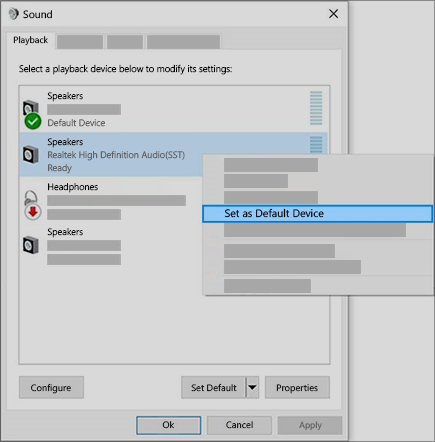
If setting your audio device equally the default device doesn't help, proceed to the next tip for additional troubleshooting.
Sometimes having audio enhancements on can consequence in audio issues. Disabling them may resolve your result.
-
In the search box on the taskbar, blazon control panel, then select it from the results.
-
Select Hardware and Audio from the Control Panel, and then select Sound.
-
On the Playback tab, select and hold (or right-click) the Default Device, and then select Backdrop.
-
Select the Avant-gardetab and uncheck either the Enable audio enhancements or the Enable sound effects cheque box (depending on which pick you see), select Utilize, and attempt to play your audio device.
-
If that doesn't work, on the Playback tab, select and hold (or correct-click) another default device (if you accept one), and select Backdrop. Uncheck either the Enable sound enhancements or the Enable sound effects check box (depending on which pick you come across), select Apply, and effort to play audio again. Do this for each default device.
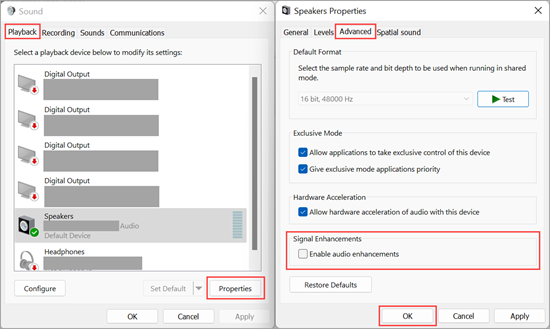
If turning off audio enhancements doesn't help, meet the next sections for boosted troubleshooting.
-
In the search box on the taskbar, blazon services, then select information technology from the results.
-
Select each of the following services, select and hold (or right-click), select Restart, and so select Yes:
-
Windows Sound
-
Windows Audio Endpoint Builder
-
Remote Procedure Call (RPC)
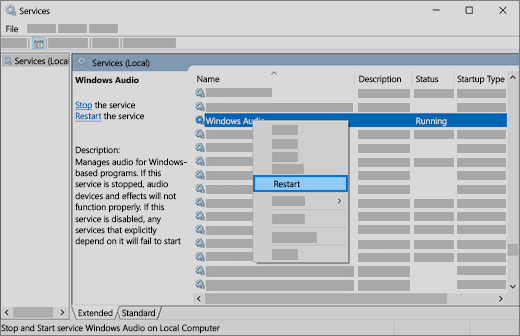
-
If restarting these services doesn't resolve your outcome, run into the next sections for more troubleshooting.
-
In the search box on the taskbar, blazon command panel, then select it from the results.
-
Select Hardware and Audio from the Command Console, and so select Sound.
-
On the Playback tab, select and hold (or right-click) Default Device, and and so select Properties.
-
On the Advanced tab, under Default Format, change the setting, select OK, and then test your audio device. If that doesn't work, endeavor irresolute the setting again.
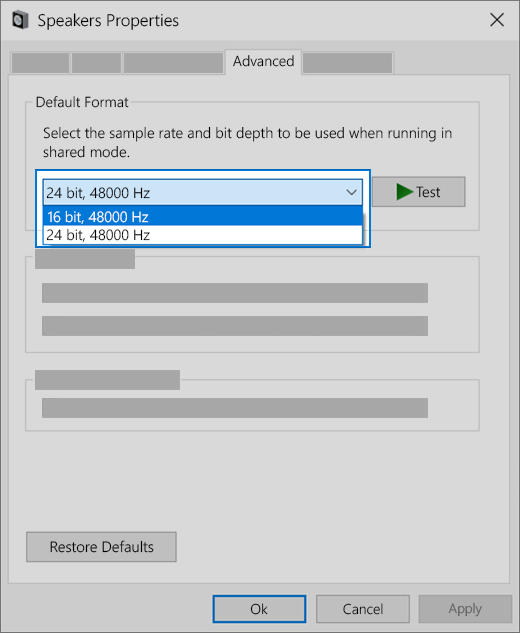
If trying different audio formats doesn't assistance, encounter the adjacent sections for additional troubleshooting.
Many updates crave you to restart your device.
To bank check and see if you accept installed updates pending and need to restart:
-
Save your work and close all open applications.
-
Select Start > Power . If y'all have installed updates pending, yous'll see options to Update and restart and Update and shut downward.
-
Select one of those restart options to utilise the updates.
Demand help with Windows Update? See Troubleshoot problems updating Windows.
If restarting doesn't help, see the next section for additional troubleshooting.
Some audio problems might exist caused by an upshot with the audio organization's IDT Loftier Definition Audio CODEC. This tin can exist fixed with a manual driver update which allows you to cull the audio commuter you want to employ.
Note:Not all systems will have an IDT Loftier Definition Audio CODEC.
To check and see if you have i, and to manually update the driver:
-
In the search box on the taskbar, type device manager, then select it from the results.
-
Select the arrow adjacent to Audio, video and game controllers to expand it.
-
Look for IDT High Definition Sound CODEC. If it's listed, select and hold (or right-click) information technology and select Update commuter,then select Browse my calculator for drivers> Allow me pick from a list of available drivers on my estimator.
-
You'll meet a listing of pre-installed drivers. Select Loftier Definition Audio Device, and then select Adjacent.
-
Select Kickoff > Settings > Privacy & security.
-
Under App permissions, select Microphone.
-
Brand sure that the Microphone access and Let apps access your microphonetoggles are turned On.
-
If yous're having this issue with a specific app, scroll down under Let apps access your microphoneand make sure that the toggle side by side to that specific app is turned On as well.
If multiple sound output devices are available, check that you have the appropriate ane selected. Here's how:
-
Select the Speakers icon on the taskbar.
Note:If you don't run across Speakers displayed, it may exist in the overflow surface area. Select Bear witness hidden icons to check at that place.
-
Next, select the pointer to open a list of sound devices connected to your reckoner.
-
Check that your audio is playing to the audio device you adopt, such as a speaker or headphones.
If this doesn't assist, continue to the adjacent tip.
The audio troubleshooter might be able to fix audio problems automatically.
To run the troubleshooter:
-
In the search box on the taskbar, blazon audio troubleshooter, select Discover and fix bug with playing sound from the results, then select Next.
-
Select the device you want to troubleshoot and so proceed through the troubleshooter.
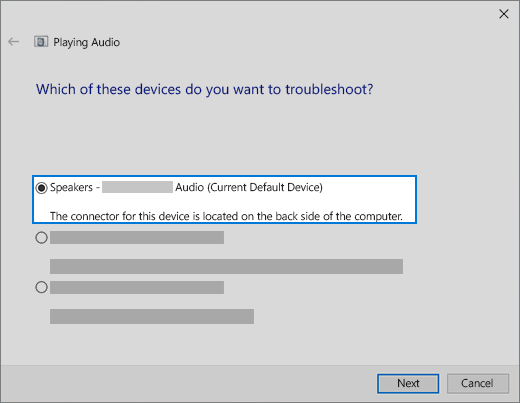
You can also launch the troubleshooter from audio Settings. Select Start > Settings > System > Sound > Troubleshoot.
If running the troubleshooter doesn't help, continue to the next tip.
To bank check for updates:
-
Select Start > Settings > Update & Security > Windows Update > Check for updates.
Open Windows Update
-
Do i of the following:
-
If the status says, "Yous're upwardly to date," go to the next tip.
-
If the status says, "Updates are available," select Install now.
-
-
Select the updates you want to install, then select Install.
-
Restart your PC and run into if your sound is working properly.
If that didn't solve your problem, keep to the next tip.
Endeavor these steps:
-
Bank check your speaker and headphone connections for loose cords or cables. Make sure all cords and cables are plugged in.
-
If you have multiple 5mm jacks to plug into, especially on a surround sound system, make sure all cords and cables are plugged into the correct jack.
-
If it's not articulate which jack goes with which string, consult your hardware manufacturer, or endeavor the nigh obvious outputs 1 at a time and come across if they work.

Notation:Some systems use a greenish jack for output and a pink jack for mic input and others will be labeled "headphone" or "microphone."


-
-
Make certain the power is turned on.
-
Make sure the mute setting is not turned on and try turning up all the volume controls.
Annotation:Some speakers and apps have their own book controls. Be certain to cheque them all.
-
Try connecting your speaker and headphones to a different USB port.
-
It'due south possible that your speakers won't work when your headphones are plugged in. Unplug your headphones and come across if that helps.
If yous're nevertheless having audio problems, encounter the next sections for additional troubleshooting.
Check to make sure your audio devices aren't muted and haven't been disabled.
-
Select and hold (or right-click) the Speakers icon on the taskbar, so select Open Volume mixer.
Note:If you don't run into Speakers displayed, it may be in the overflow expanse. Select Show hidden icons to check there.
-
Y'all'll run into a set up of volume controls for your devices. Make sure none of them are muted. If whatever of them are muted, yous'll see a red circumvolve with a line through information technology next to the volume command. In that instance, select the volume control to unmute.
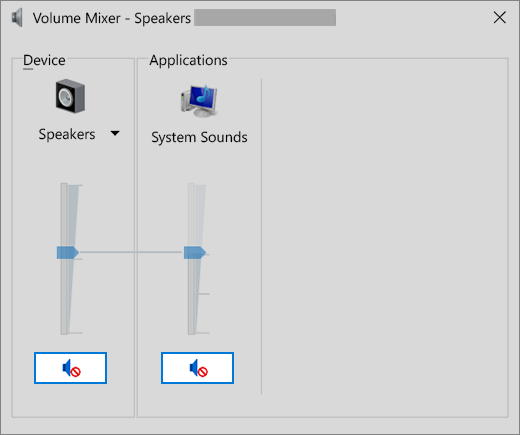
-
Check your device properties to make sure that your devices have non been disabled past mistake. Select Offset > Settings > System > Sound .
-
Select your audio device, and so select Device properties. Be sure to selectDevice backdrop for both the output and input devices.
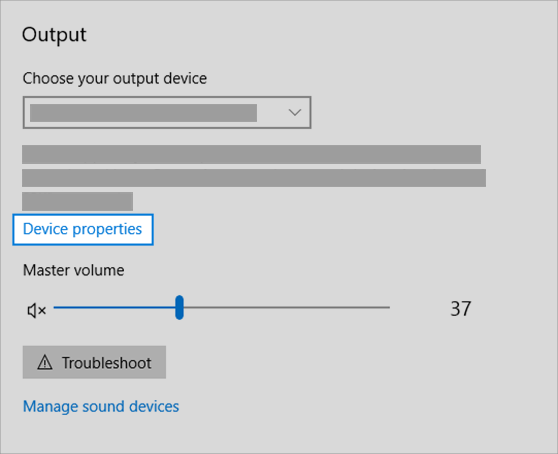
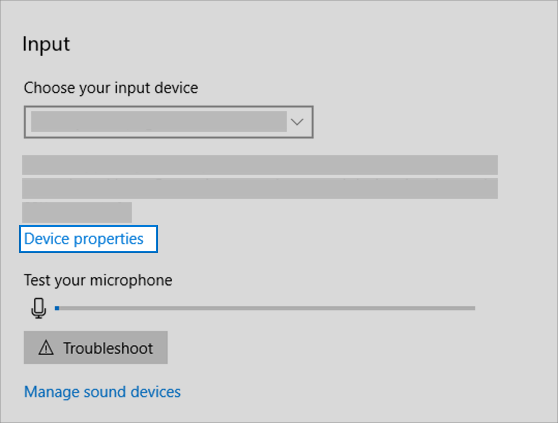
-
Make sure the Disable check box is cleared for the output and input devices.
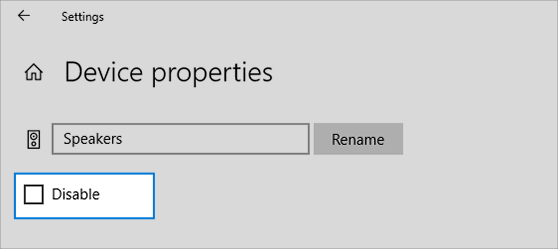
If that didn't solve your trouble, proceed to the next tip.
Hardware problems can be caused past outdated or malfunctioning drivers. Brand sure your audio driver is upward to date and update it if needed. If that doesn't piece of work, try uninstalling the audio driver (it will reinstall automatically). If that doesn't work, try using the generic audio commuter that comes with Windows. If you're having audio issues after installing updates, try rolling back your sound driver.
To update your audio driver automatically:
-
In the search box on the taskbar, type device manager, then select it from the results.
-
Select the arrow next to Sound, video and game controllers to expand it.
-
Select and agree (or right-click) the listing for your sound card or audio device, such as headphones or speakers, select Update driver, then select Search automatically for updated driver software. Follow the instructions to consummate the update.

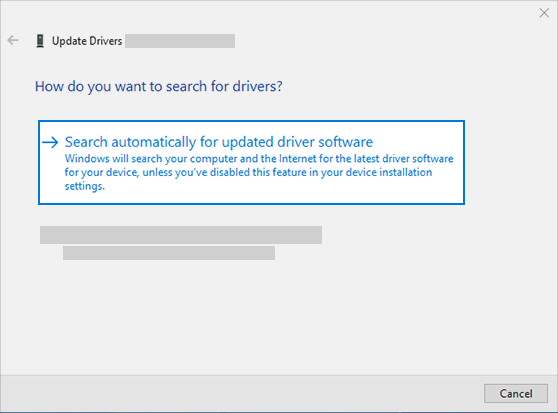
If Windows doesn't notice a new driver, await for one on the device manufacturer'due south website and follow those instructions. If that doesn't work, try uninstalling your sound driver.
To uninstall your audio driver:
-
In the search box on the taskbar, type device manager, then select it from the results.
-
Select the pointer next to Sound, video and game controllers to expand information technology.
-
Correct-click the listing for your sound carte or audio device, select Uninstall device,select the Delete the commuter software for this device check box, and so select Uninstall.
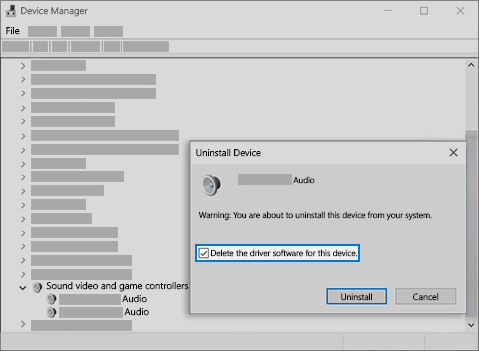
-
Restart your PC.
-
Note: Exist sure to save documents and any other current work before y'all restart.
-
This restart will automatically prompt your PC to reinstall your audio driver.
-
To restart, select Start > Power > Restart .
-
If those options didn't work, endeavor using the generic audio commuter that comes with Windows.
To employ the generic audio commuter that comes with Windows:
-
In the search box on the taskbar, blazon device director, so select it from the results.
-
Select the arrow next to Sound, video and game controllers to expand it.
-
Select and concur (or right-click) the listing for your sound card or audio device, then select Update commuter > Browse my estimator for drivers> Let me pick from a list of device drivers on my calculator.
-
Select the audio device whose driver you want to update, select Next, and then follow the instructions to install information technology.

If these steps didn't solve your sound issue, visit your device manufacturer'south website, and install the near recent audio or sound drivers for your device. The post-obit is an instance of a commuter download folio for a sound device manufacturer.

If you have audio issues subsequently installing updates
If your audio was working before you ran Windows Update and now isn't working, endeavor rolling dorsum your audio commuter.
To roll back your audio commuter:
-
In the search box on the taskbar, type device director, then select it from the results.
-
Select the arrow adjacent to Sound, video and game controllers to expand information technology.
-
Select and agree (or correct-click) the listing for your sound carte du jour or audio device, then select Properties.
-
Select the Driver tab, and then select Roll Back Driver.

-
Read and follow the instructions then selectYeah if you want to roll back your audio driver.
If rolling back your sound driver didn't work or wasn't an selection, you can try to restore your PC from a arrangement restore bespeak.
Restore your PC from a organisation restore point:
When Microsoft installs updates on your system, nosotros create a system restore signal in case problems arise. Endeavour restoring from that betoken and see if that fixes your sound bug. For more than info, come across "Restore from a organisation restore point" in Recovery options in Windows.
If you're connecting to an audio device—such as headphones or speakers—using USB or HDMI, you might need to set that device as the default audio device. If y'all're using an external monitor that doesn't take built-in speakers, make sure that the monitor isn't already selected as your default output device. If information technology is, yous won't have any sound. You can check that when you lot set your default output audio device. Here's how:
-
In the search box on the taskbar, type control panel, then select information technology from the results.
-
Select Hardware and Audio from the Control Panel, and then select Audio.
-
On the Playback tab, select and concord (or right-click) the listing for your sound device, select Fix as Default Device, and so select OK.

If setting your audio device every bit the default device doesn't assist, continue to the next tip for additional troubleshooting.
Sometimes having audio enhancements on can result in audio issues. Disabling them may resolve your consequence.
-
In the search box on the taskbar, type command panel, then select information technology from the results.
-
Select Hardware and Sound from the Control Panel, and and then select Audio.
-
On the Playback tab, select and hold (or right-click) the Default Device, and then select Properties.
-
On the Enhancements tab, select either the Disable all enhancements or the Disable all sound furnishings cheque box (depending on which option y'all see), select OK, and try to play your audio device.
-
If that doesn't work, on the Playback tab, select and agree (or right-click) another default device (if y'all have one), then select Backdrop. On the Enhancements tab select either the Disable all enhancements or the Disable all sound effects cheque box (depending on which selection you see), select OK, and try to play sound once more. Do this for each default device.
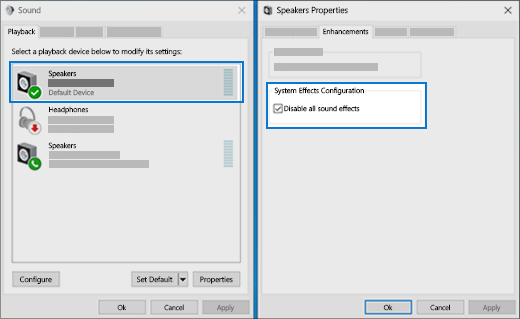
If turning off audio enhancements doesn't help, run into the next sections for additional troubleshooting.
-
In the search box on the taskbar, blazon services, and so select it from the results.
-
Select each of the post-obit services, correct-click, so select Restart:
-
Windows Audio
-
Windows Sound Endpoint Builder
-
Remote Procedure Call (RPC)

-
If restarting these services doesn't resolve your issue, see the side by side sections for more than troubleshooting.
-
In the search box on the taskbar, type control panel, and then select it from the results.
-
Select Hardware and Sound from the Command Panel, and and so select Sound.
-
On the Playback tab, select and concord (or correct-click)Default Device, and and then select Properties.
-
On the Advanced tab, under Default Format, modify the setting, select OK, and so examination your sound device. If that doesn't piece of work, try changing the setting once again.

If trying different audio formats doesn't help, see the next sections for additional troubleshooting.
Many updates require you to restart your device.
To check and encounter if you have installed updates awaiting and demand to restart
-
Relieve your work and close all open up applications.
-
Select Start > Ability . If you accept installed updates awaiting, yous'll meet options to Update and restart and Update and close down.
-
Select one of those restart options to apply the updates.
Need assist with Windows Update? See Troubleshoot issues updating Windows.
If restarting doesn't assist, see the next section for additional troubleshooting.
Some sound problems might be acquired by an issue with the sound system's IDT High Definition Audio CODEC. This can be stock-still with a manual driver update which allows you to choose the sound driver you want to utilise.
Note:Not all systems volition accept an IDT Loftier Definition Audio CODEC.
To check and see if you take one, and to manually update the driver:
-
In the search box on the taskbar, type device manager, then select it from the results.
-
Select the arrow next to Sound, video and game controllers to expand information technology.
-
Look for IDT High Definition Audio CODEC. If it's listed, select and concord (or right-click) it and select Update driver, then select Scan my computer for drivers> Let me selection from a list of device drivers on my computer.
-
Y'all'll see a listing of pre-installed drivers. Select High Definition Audio Device, and and then select Adjacent.
-
Select Start > Settings > Privacy , and so select Microphone from the left carte du jour.
-
Nether Let access to the microphone on this device, select Change. Make sure the toggle is turned On.
-
If you're having this consequence with a specific app, scroll down to Choose which Microsoft Store apps can access your microphone and make sure that the toggle next to that app is turned On too.
How Can I Fix My Audio Output Device Ffxiv,
Source: https://support.microsoft.com/en-us/windows/fix-sound-or-audio-problems-in-windows-73025246-b61c-40fb-671a-2535c7cd56c8
Posted by: lopezbeforavy43.blogspot.com


0 Response to "How Can I Fix My Audio Output Device Ffxiv"
Post a Comment